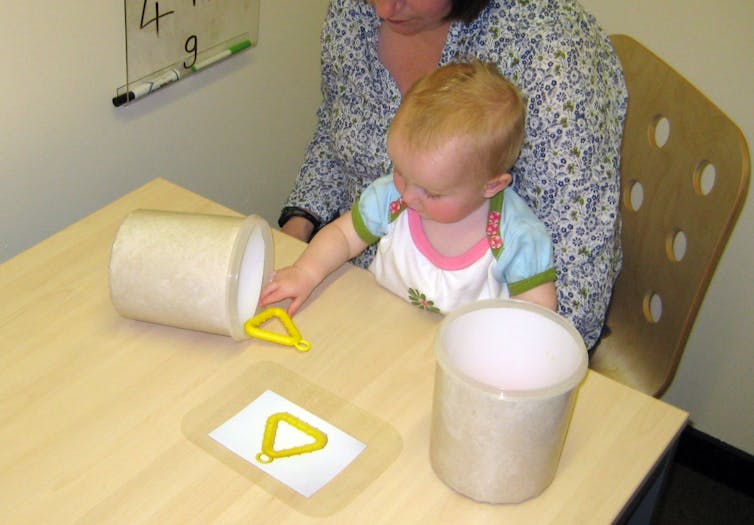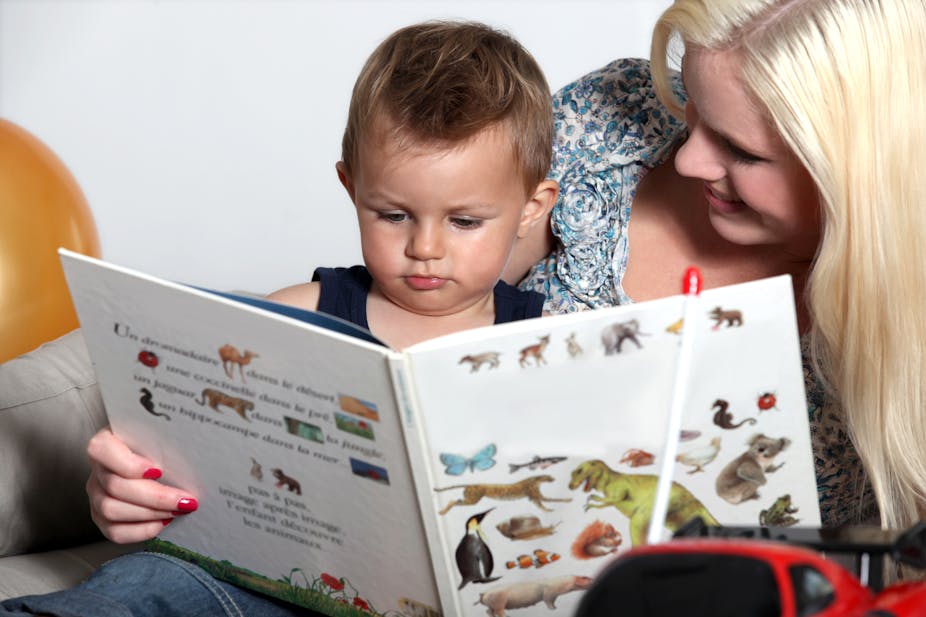Mass media such as books, TV, and the internet are key sources of information, allowing us to increase our knowledge by learning indirectly about things we’ve never directly experienced.
Is this true for babies as well as adults? Babies today typically have a lot of experience with picture books, yet still exhibit signs of confusion. They eat books, grasp at photos of objects as if they were real, and read picture books upside down. How well can babies learn from these sources if they misunderstand their symbolic properties?
Researchers have only recently begun testing this question, with few positive findings to date. Studies from the labs of Judy DeLoache and Patricia Ganea find little evidence that babies under 15 months who are taught a new word for an object from a picture book or video can apply that word to the real object.
My research has tried to add to this by testing how even younger babies learn from pictures. Our study shows that by at least nine months old, babies can learn about an object from its photo and transfer that learning to the real object when they encounter it.
At the Royal Holloway Baby Lab, we showed eight to nine-month-old babies a life-size photo of a toy for about a minute.
Half the babies saw a colour photo of the toy and half saw only a black-and-white photo. We wanted to see if the picture had to match the real toy’s colour in order for babies to learn about one from the other.
We then paired the real target toy with a distractor (a novel toy that was different from the one in the picture) and observed which one the babies reached for first.
In one condition, we tested simple object recognition for the target toy by keeping both toys visible in transparent containers. In the other condition, we tested babies’ continued representation of the target toy’s existence by hiding both toys in opaque containers while they watched.

We found that when the toys remained visible, babies reached twice as often for the distractor than the target. This preference for novelty when given a choice between two objects is a well-established sign of recognition memory in babies. It suggests they recognised the target toy as being familiar, from their experience with its picture, and found it less interesting than the distractor toy.
However, after the toys were hidden, babies showed the reverse preference. They reached more for the familiar target toy than the novel distractor toy. This contradictory preference for familiarity when objects become hidden tells us something important about babies’ understanding of “object permanence” – that objects continue to exist even when they can’t be seen.
It suggests that seeing the picture built up such a strong memory of the target toy that it helped them remember the toy still existed even after it disappeared. In contrast, babies’ memory for the novel distractor was too weak to help them remember it still existed.
Black and white has no impact
We also expected that babies who saw black-and-white photos might reach randomly for the two toy types, because the pictures lacked information about the real toy’s colour, which might be important to learning.
This prediction was based on other findings, for example, by Ganea and colleagues, suggesting that babies are more likely to see the relation between an object’s picture and the real object when they are the same colour.
But in our study, babies who saw black-and-white photos reached for the toys in the same pattern as babies who saw colour photos. This shows that a colour match doesn’t always enhance learning. Photos are probably realistic enough that colour information isn’t necessary to see the similarity.
Out of sight, not out of mind
These findings change our previous understanding of children’s picture-based learning in several ways. They show that a single brief exposure to an object’s picture affects babies’ actions with the real object. And that when something is out of a baby’s sight, it is not necessarily out of mind. This is also the first demonstration that babies as young as eight or nine months can transfer learning from black-and-white photos to objects.
Other researchers show that if toddlers of 15 to 24 months are shown iconic images such as photos or highly-realistic drawings they are more likely to learn from them than less-realistic cartoon drawings. Still others, such as Medha Tare and colleagues, find that manipulative features in baby books, such as pop-ups and pull-tabs, actually hinder children’s ability to remember pictures.
Although more research needs to be done, combining these findings suggests that if the goal of picture books is to educate (rather than simply entertain), babies might find it easiest to learn from highly realistic images with no manipulative features.

